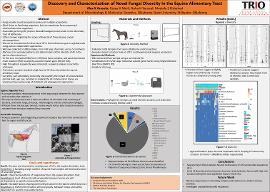| dc.contributor.advisor | Elshahed, Mostafa S. | |
| dc.contributor.author | Arreola, Alex X. | |
| dc.contributor.author | Meili, Casey H. | |
| dc.contributor.author | Youssef, Noha H. | |
| dc.date.accessioned | 2021-10-01T18:18:48Z | |
| dc.date.available | 2021-10-01T18:18:48Z | |
| dc.date.issued | 2021-10-09 | |
| dc.identifier | oksd_OK-LSAMP_2021_arreola | |
| dc.identifier.citation | Arreola, A. X., Meili, C. H., Youssef, N. H., & Elshahed, M. S. (2021, October 9). Discovery and characterization of novel fungal diversity in the equine alimentary tract. Poster presented at the Oklahoma Louis Stokes Alliance for Minority Participation's 27th Annual Research Symposium, Stillwater, OK. | |
| dc.identifier.uri | https://hdl.handle.net/11244/331008 | |
| dc.description.abstract | Fungi provide crucial ecosystem services in multiple ecosystems. Most fungi thrive as free-living organisms, but many forge symbiotic, predatory, pathogenic, and commensal relationships with algae, plants, and animals. One of the most peculiar groups of fungi are the anaerobic gut fungi (phylum Neocallimastigomycota) that reside in the alimentary tract of herbivores. Little is known regarding the scope of diversity of these elusive, anoxic microorganisms. Our work aims to characterize the diversity of AF’s in the herbivorous gut on a global scale using culture independent approaches. We have collected >1,000 samples, from >50 type of animals, across 5 continents. My focus in this broader project is to examine patterns and determinants of the diversity of AF in equine alimentary tract. To this end, I extracted DNA from >100 fecal horse samples, and used polymerase chain reaction (PCR) to amplify a specific marker gene (D1/D2 LSU). High throughput sequencing was conducted, and analysis of the sequence data is currently underway. My preliminary analysis revealed a high level of AF diversity within the equine alimentary tract, as evident by the detection of > 30 different cultured and yet-uncultured AF genera in these samples. Moreover, a fraction of the sequenced obtained belong to multiple novel, hitherto undiscovered lineages, clearly indicated that the scope of AF diversity in the equine alimentary tract is much broader than previously suggested. Currently, I am attempting to identify and quantify the impact of various factors (animal feed, age, sex, location) in shaping the AF community in horses via implementing a wide range of statistical and phylogenetic approaches. | |
| dc.description.sponsorship | Oklahoma Louis Stokes Alliance for Minority Participation Program | |
| dc.description.sponsorship | National Science Foundation (U.S.) | |
| dc.description.sponsorship | Ronald E. McNair Post-Baccalaureate Achievement Program | |
| dc.description.sponsorship | Lew Wentz Foundation | |
| dc.format | application/pdf | |
| dc.language | en_US | |
| dc.publisher | Oklahoma State University | |
| dc.rights | In the Oklahoma State University Library's institutional repository this paper is made available through the open access principles and the terms of agreement/consent between the author(s) and the publisher. The permission policy on the use, reproduction or distribution of the article falls under fair use for educational, scholarship, and research purposes. Contact Digital Resources and Discovery Services at lib-dls@okstate.edu or 405-744-9161 for further information. | |
| dc.title | Discovery and characterization of novel fungal diversity in the equine alimentary tract | |
| osu.filename | oksd_OK-LSAMP_2021_arreola.pdf | |
| dc.description.department | Microbiology and Molecular Genetics | |
| dc.type.genre | Poster | |
| dc.type.material | Text | |
| dc.subject.keywords | anaerobic fungi | |
| dc.subject.keywords | equine mycobiome | |
